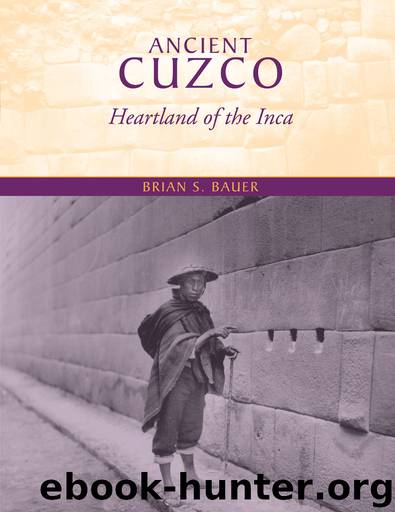Ancient Cuzco by Brian S. Bauer

Author:Brian S. Bauer [Bauer, Brian S.]
Language: eng
Format: epub
Publisher: University of Texas Press
Published: 2004-11-09T05:00:00+00:00
PHOTO 10.19. A high interior niche and one side of a doorway of what was once a great hall within Hatuncancha can be seen along Avenida Santa Catalina Angosta.
The Pucamarca Compound
Another large compound to the south of the plaza was called Pucamarca.83 Garcilaso de la Vega (1966: 424 [1609: Pt. 1, Bk. 7, Ch. 9]) suggests that this ward was associated with Topa Inca Yupanqui; however, he may have been confused with the adjacent compound, Cusicancha, in which Topa Inca Yupanqui was born. The area of Pucamarca is also briefly mentioned by Guaman Poma de Ayala (1980: 310 [1615: 337 (339)]).
Little additional information is available on this sector of Cuzco other than scattered, and partially contradictory, references to the locations of two temples within it.84 Cobo (1990: 58 [1653: Bk. 13, Ch. 13]), while describing the shrines of Cuzco, states that Pucamarca was “a house or temple designated for the sacrifices of the Pachayachachic [Creator] in which children were sacrificed and everything else.”85 Elsewhere he notes that there was a temple named Pucamarca “in the houses which belonged to the Licentiate [Antonio] de la Gama;86 in it was an idol of the Thunder called Chucuylla” (Cobo 1990: 57 [1653: Bk. 13, Ch. 13]).87 These two temples are also mentioned by Albornoz, who writes, “Pucamarca quisuarcancha, which was the house of the Creator and of the Thunders.”88
Molina, when writing of the works of Pachacuti Inca Yupanqui, provides a few additional details on these temples and the ward of Pucamarca:89
. . . he ordered built the houses and temple of Quisuarcancha, which are above the houses of Diego Hortiz de Guzmán,90 coming from the plaza of Cuzco, where Hernando López de Segovia91 now lives. There he put the gold statue of the Creator, the size of a ten-year-old boy. It was in the shape of a man standing, the right arm raised high with his hand almost closed and his fingers raised, like a person who was ordering.92 (Translation by author)
In a later section of his account, Molina offers supporting, yet slightly contradictory information, suggesting that the temple of Quisuarcancha was located in Pucamarca, but in the house lot owned by Isabel de Bobadilla (not Hernando López de Segovia):
. . . they carried to the Temple of the Sun the figures called Chuquilla and Wiracocha, which had their own temple in Pucamarca and Quisuarcancha which are now the houses of Doña Isabel de Bobadilla.93 (Translation by author)
Loarte (1882: 230 [1572]), writing in Cuzco at the same time as Molina,94 confirms the fact that Isabel de Bobadilla owned a house in Pucamarca.
In sum, although our information is fragmentary at best, it seems likely that the area of Pucamarca was located in the large city block to the west of the Acllahuaci and south of the Hatuncancha. If this is the case, then the impressive Inca wall that remains on Maruri Street may have belonged to Pucamarca (Photo 10.20). Within this sector of Cuzco were two temples, one dedicated to the Creator god and the other to Thunder.
Download
This site does not store any files on its server. We only index and link to content provided by other sites. Please contact the content providers to delete copyright contents if any and email us, we'll remove relevant links or contents immediately.
The Vikings: Conquering England, France, and Ireland by Wernick Robert(79845)
Ali Pasha, Lion of Ioannina by Eugenia Russell & Eugenia Russell(40103)
The Conquerors (The Winning of America Series Book 3) by Eckert Allan W(36960)
The Vikings: Discoverers of a New World by Wernick Robert(36903)
Cecilia; Or, Memoirs of an Heiress — Volume 1 by Fanny Burney(32396)
Cecilia; Or, Memoirs of an Heiress — Volume 3 by Fanny Burney(31775)
Cecilia; Or, Memoirs of an Heiress — Volume 2 by Fanny Burney(31744)
Empire of the Sikhs by Patwant Singh(22922)
The Secret History by Donna Tartt(18787)
Hans Sturm: A Soldier's Odyssey on the Eastern Front by Gordon Williamson(18448)
Cat's cradle by Kurt Vonnegut(15126)
Pimp by Iceberg Slim(14255)
Sapiens: A Brief History of Humankind by Yuval Noah Harari(14183)
Talking to Strangers by Malcolm Gladwell(13156)
Norse Mythology by Gaiman Neil(13154)
Leonardo da Vinci by Walter Isaacson(13128)
4 3 2 1: A Novel by Paul Auster(12245)
Underground: A Human History of the Worlds Beneath Our Feet by Will Hunt(11992)
The Radium Girls by Kate Moore(11886)
